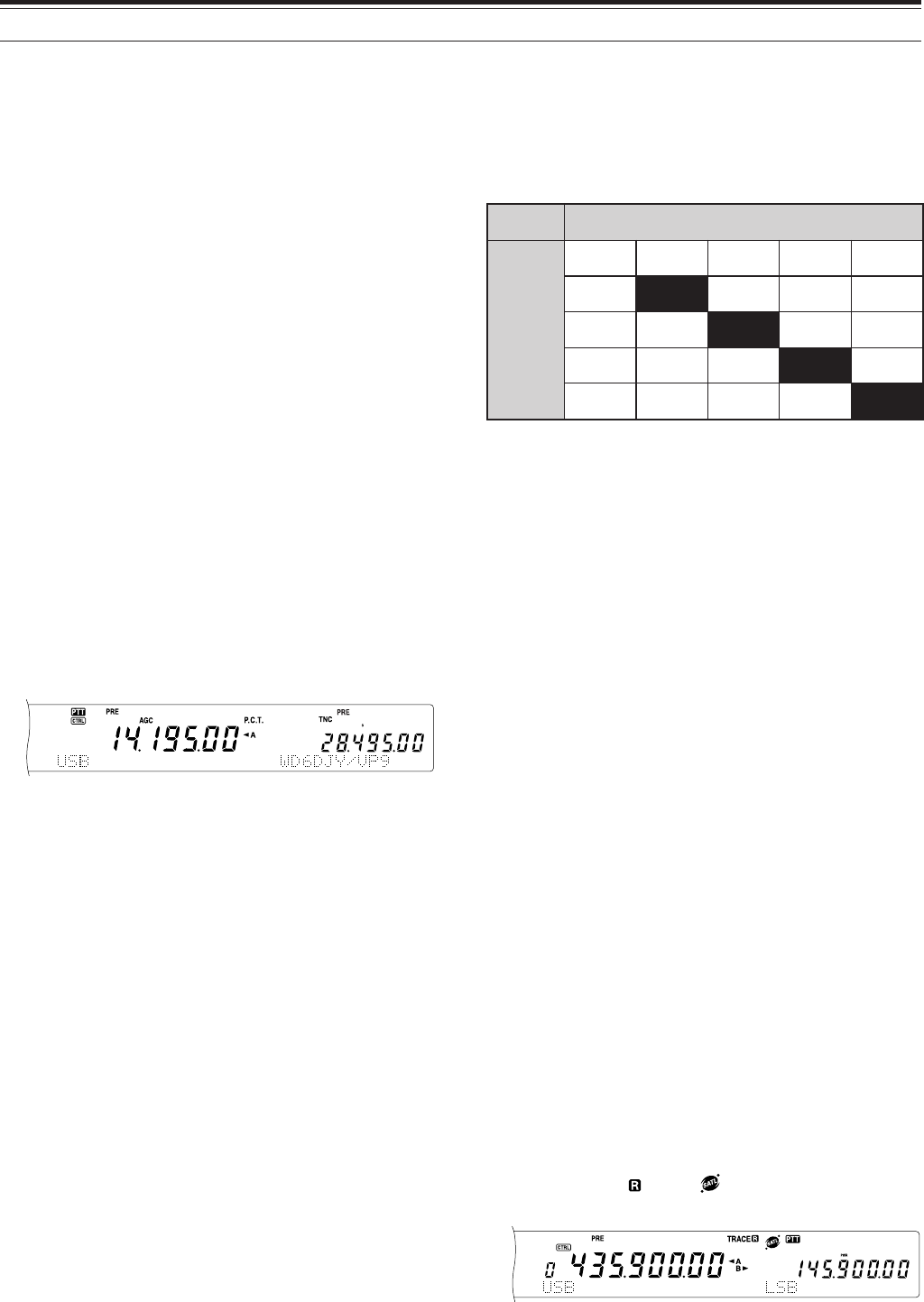
53
11 SPECIALIZED COMMUNICATIONS
DX PACKET CLUSTER TUNE
DX Packet Cluster is a packet network which consist
of nodes and stations who are interested in DXing
and contesting. If one station finds a DX station on
the air, he or she sends a notice to his or her node.
This node then passes the information to all its local
stations as well as another node. This transceiver
can display received DX information and hold the
latest information on up to 10 DX stations.
This transceiver is also capable of automatically
tuning in a reported DX station. In order to use the
Auto Tune function, access Menu No. 49A and select
“AUTO”; the default is “MANUAL”.
1 Press [A/B] to select VFO A or VFO B.
2 Press the SUB AF control to activate the sub-
receiver if it is switched OFF.
• The orange SUB LED lights {page 45}.
3 Tune to the frequency of the target DX Packet
Cluster node on the sub-receiver.
4 Access Menu No. 46 to confirm that “SUB” is
selected.
5 Press [FUNC], [SET/ P.C.T.] to enter the Packet
Cluster Tune (P.C.T.) mode.
• Each time new DX Packet Cluster data is
received, the DX station’s callsign in Morse
code sounds and the information is displayed
on the sub-receiver as shown below:
6 If you are not using the Auto Tune function, press
[SET/ P.C.T.].
• The main transceiver is tuned to the frequency
of the reported DX station, on the sub-receiver.
• Transmitting on the tuned frequency, the
transceiver exits the P.C.T. mode. Press
[FUNC], [SET/ P.C.T.] again to reactivate it if
necessary.
7 Press [FUNC], [SET/ P.C.T.] to exit the P.C.T.
mode.
To access desired DX information in the P.C.T
memory, press QUICK MEMO [MR], then turn the
MULTI/ CH control. Press [SET/ P.C.T.] to tune the
main band to the selected station. Press QUICK
MEMO [MR] again to quit the DX information display.
The transceiver can be set to output a beep instead
of a Morse code when new DX Packet Cluster data is
received. Access Menu No. 49B and select “OFF”.
“VOICE” can also be set when you install the optional
VS-3 {page 91}.
Note:
◆
You cannot send DX information to a node using this function.
◆
The DX Packet Cluster data in memory is retained when the
transceiver is turned OFF. However, the sub-receiver’s
frequency display returns to the receiving frequency of the DX
Packet Cluster node.
SATELLITE OPERATION
Amateur satellites receive on one band and transmit
on another. Unlike in regular operation, Satellite
mode can handle uplink/ downlink frequency
combinations simultaneously in all operating modes
as shown below.
KNILPU
NWOD
KNIL
dnaB
~FH
zHM05
zHM441
/034
zHM044
zHG2.1
~FH
zHM05
√√√
zHM441
√ √√
/034
zHM044
√√ √
zHG2.1
√√√
Some satellites require a rotator that allows azimuth
and elevation control, plus a high-gain directional
antenna. The antenna must track the satellite which
travels from horizon to horizon. Even so, many hams
have been successfully using fixed omnidirectional
antennas. If you are using a directional antenna, it
would be wise to obtain a pass prediction program.
Doppler Shift is another aspect that you must take
into account when working the satellites. As a target
satellite travels away, frequencies on which you will
receive change. This transceiver has a function that
automatically keeps the sum or difference between
the two frequencies identical when you change the
receive frequency.
For further information, consult Internet Web pages
relating to Amateur satellites. On Internet search
engines, use “AMSAT” as key words to find those
Web pages. Or, you can directly go to the AMSAT
(the Radio Amateur Satellite Corporation) homepage
at http://www.amsat.org. From AMSAT Web pages,
you can download a variety of utilities, including pass
prediction programs, which will ease your satellite
operations.
BASIC OPERATION
When you enter the Satellite mode, you are always
controlling one of 10 Satellite Memory channels with
the adjustable frequency function. The Satellite
Memory channel number (0 ~ 9) appears on the main
transceiver’s display when you enter the mode.
1 Press [SATL] to enter Satellite mode.
• The default downlink (435.9 MHz) and uplink
(145.9 MHz) frequencies appear.
• “TRACE”, “ ”, and “ ” appear to indicate the
current selections.
2 On VFO A, tune to the downlink (RX) frequency of
the satellite.


















